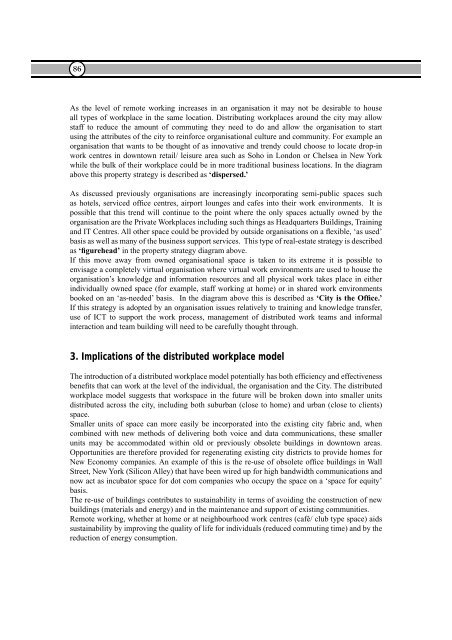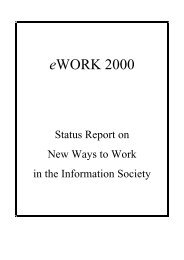Proceedings of 8th European Assembly on telework (Telework2001)
Proceedings of 8th European Assembly on telework (Telework2001)
Proceedings of 8th European Assembly on telework (Telework2001)
Create successful ePaper yourself
Turn your PDF publications into a flip-book with our unique Google optimized e-Paper software.
86As the level <str<strong>on</strong>g>of</str<strong>on</strong>g> remote working increases in an organisati<strong>on</strong> it may not be desirable to houseall types <str<strong>on</strong>g>of</str<strong>on</strong>g> workplace in the same locati<strong>on</strong>. Distributing workplaces around the city may allowstaff to reduce the amount <str<strong>on</strong>g>of</str<strong>on</strong>g> commuting they need to do and allow the organisati<strong>on</strong> to startusing the attributes <str<strong>on</strong>g>of</str<strong>on</strong>g> the city to reinforce organisati<strong>on</strong>al culture and community. For example anorganisati<strong>on</strong> that wants to be thought <str<strong>on</strong>g>of</str<strong>on</strong>g> as innovative and trendy could choose to locate drop-inwork centres in downtown retail/ leisure area such as Soho in L<strong>on</strong>d<strong>on</strong> or Chelsea in New Yorkwhile the bulk <str<strong>on</strong>g>of</str<strong>on</strong>g> their workplace could be in more traditi<strong>on</strong>al business locati<strong>on</strong>s. In the diagramabove this property strategy is described as ‘dispersed.’As discussed previously organisati<strong>on</strong>s are increasingly incorporating semi-public spaces suchas hotels, serviced <str<strong>on</strong>g>of</str<strong>on</strong>g>fice centres, airport lounges and cafes into their work envir<strong>on</strong>ments. It ispossible that this trend will c<strong>on</strong>tinue to the point where the <strong>on</strong>ly spaces actually owned by theorganisati<strong>on</strong> are the Private Workplaces including such things as Headquarters Buildings, Trainingand IT Centres. All other space could be provided by outside organisati<strong>on</strong>s <strong>on</strong> a flexible, ‘as used’basis as well as many <str<strong>on</strong>g>of</str<strong>on</strong>g> the business support services. This type <str<strong>on</strong>g>of</str<strong>on</strong>g> real-estate strategy is describedas ‘figurehead’ in the property strategy diagram above.If this move away from owned organisati<strong>on</strong>al space is taken to its extreme it is possible toenvisage a completely virtual organisati<strong>on</strong> where virtual work envir<strong>on</strong>ments are used to house theorganisati<strong>on</strong>’s knowledge and informati<strong>on</strong> resources and all physical work takes place in eitherindividually owned space (for example, staff working at home) or in shared work envir<strong>on</strong>mentsbooked <strong>on</strong> an ‘as-needed’ basis. In the diagram above this is described as ‘City is the Office.’If this strategy is adopted by an organisati<strong>on</strong> issues relatively to training and knowledge transfer,use <str<strong>on</strong>g>of</str<strong>on</strong>g> ICT to support the work process, management <str<strong>on</strong>g>of</str<strong>on</strong>g> distributed work teams and informalinteracti<strong>on</strong> and team building will need to be carefully thought through.3. Implicati<strong>on</strong>s <str<strong>on</strong>g>of</str<strong>on</strong>g> the distributed workplace modelThe introducti<strong>on</strong> <str<strong>on</strong>g>of</str<strong>on</strong>g> a distributed workplace model potentially has both efficiency and effectivenessbenefits that can work at the level <str<strong>on</strong>g>of</str<strong>on</strong>g> the individual, the organisati<strong>on</strong> and the City. The distributedworkplace model suggests that workspace in the future will be broken down into smaller unitsdistributed across the city, including both suburban (close to home) and urban (close to clients)space.Smaller units <str<strong>on</strong>g>of</str<strong>on</strong>g> space can more easily be incorporated into the existing city fabric and, whencombined with new methods <str<strong>on</strong>g>of</str<strong>on</strong>g> delivering both voice and data communicati<strong>on</strong>s, these smallerunits may be accommodated within old or previously obsolete buildings in downtown areas.Opportunities are therefore provided for regenerating existing city districts to provide homes forNew Ec<strong>on</strong>omy companies. An example <str<strong>on</strong>g>of</str<strong>on</strong>g> this is the re-use <str<strong>on</strong>g>of</str<strong>on</strong>g> obsolete <str<strong>on</strong>g>of</str<strong>on</strong>g>fice buildings in WallStreet, New York (Silic<strong>on</strong> Alley) that have been wired up for high bandwidth communicati<strong>on</strong>s andnow act as incubator space for dot com companies who occupy the space <strong>on</strong> a ‘space for equity’basis.The re-use <str<strong>on</strong>g>of</str<strong>on</strong>g> buildings c<strong>on</strong>tributes to sustainability in terms <str<strong>on</strong>g>of</str<strong>on</strong>g> avoiding the c<strong>on</strong>structi<strong>on</strong> <str<strong>on</strong>g>of</str<strong>on</strong>g> newbuildings (materials and energy) and in the maintenance and support <str<strong>on</strong>g>of</str<strong>on</strong>g> existing communities.Remote working, whether at home or at neighbourhood work centres (café/ club type space) aidssustainability by improving the quality <str<strong>on</strong>g>of</str<strong>on</strong>g> life for individuals (reduced commuting time) and by thereducti<strong>on</strong> <str<strong>on</strong>g>of</str<strong>on</strong>g> energy c<strong>on</strong>sumpti<strong>on</strong>.








